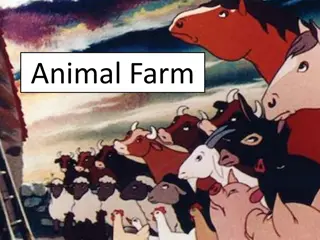Exploration of Colonial Discourse in George Orwell's "Shooting an Elephant
George Orwell's "Shooting an Elephant" delves into the psychological conflict of a police officer upholding British imperial rule in Burma. The narrative unravels Orwell's ambivalence towards colonialism, his struggles with authority and identity, and the complexities of power dynamics and moral responsibility. As Orwell grapples with his role in the imperial mission, the essay exposes the dehumanizing effects of imperialism through a lens of white man's burden and the internal struggles of the colonial subject.
Download Presentation

Please find below an Image/Link to download the presentation.
The content on the website is provided AS IS for your information and personal use only. It may not be sold, licensed, or shared on other websites without obtaining consent from the author. Download presentation by click this link. If you encounter any issues during the download, it is possible that the publisher has removed the file from their server.
E N D
Presentation Transcript
Prepared for the Students of Part II
George Orwell: Holds the central role being a police officer who despises the British imperial project in Burma in , sides with the Burmese, yet attempts to prove his authority to the Burmese. The sub-inspector: A Burmese policeman who answers to Orwell . He s waiting for Orwell at the bazaar where the elephant has been rampaging. The Dead Man: A body trampled into mud by the rampaging elephant.
Imperialism Colonial Discourse Representation Identity Politics White Man s Burden Mimicry
The narrative of the essay unpacks Orwells psychological conflict while performing his duty as a police officer for the British Raj in colonial Burma In his role of representing the British Empire he upholds the stance of ambivalence His ambivalent attitude is expressed in his confession of hatred for the colonial mission practicing entrenched hostility towards the colonised other i.e. the Burmese people.
On the other hand the combination of his sympathetic gesture and resentment towards the Burmese people who never used to leave a scope to harass him further emphasizes his psychological dilemma. Orwell himself becomes a subject being a part of the colonial mission justifying the self-other binary.
In order to keep the narratives of colonial discourse undisturbed, he keeps on identifying the Burmese populace as images of yellow faces , mysterious beings, inborn liars, full of satanic litany and animalistic intent. The politics of the accepted superiority of the Empire and the acknowledged inferiority of the Burmese people is further emphasized through the expression of their eager eyes ready to witness the theatre of killing of the elephant by the colonial master , represented by Orwell himself.
Orwell himself becomes the subject carrying the white man s burden His conflicted emotion reaches its height when he is to control the elephant undergoing a bout of must breaks its chain His moral consideration holds him back from killing the elephant while his elevated status being a part of the imperialistic mission demands his coerssive performance to fulfil the demanding eyes of the natives
The dramatic act of killing the elephant by his repetitive application of bullets in disparate parts of the body earns him acclaim from the natives The narrative ends with the question of aptness of the act of killing performed by Orwell, the colonial police officer who was to measure the value of life of the Burmese coolie whom the elephant trampled, with the value of the animal that he himself killed
The Policeman : As a police officer, Orwells presence holds symbolic power in Burmese society. The tortured body: The image of the naked, scarred buttocks of a prisoner represents the power structure dominant in the Geographical domain referred to. The Elephant : The rampaging elephant is a symbol of Burmese society , uncontrollable and violent , making itself known by jeers and humiliation. The Crowd: As a motif the crowd reflects the eyes of Burmese society, closely observing their colonizers.
The Act of Shooting the Elephant: The shooting of the elephant functions as an allegory for the British colonial project in Burma. Orwell psychological dilemma before killing the elephant represents the guilt of attempting to command over an entire culture and society.























